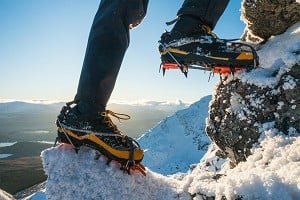
Are you a walker, a mountaineer, a climber or a bit of all three? Dan Bailey tries out three winter boots, each designed for a different niche - Meindl's Himalaya MFS (B1), the Berghaus Kibo (B2) and Mammut's Mamook GTX (B3).
Winter boots should be warm, waterproof and supportive, with soles stiff enough to hold an edge in hard snow and of course able to take a crampon. But there's more to it than that. Your choice of boot should suit the intended use, since footwear designed primarily for walking won't be ideal for climbing - and vice versa. An unofficial industry scale rates winter boots according to the type of crampon with which they are compatible, and also serves as a rough guide to a boot's stiffness and the activities for which it's best suited.
B1 boots have some flex in the sole, and are only suitable for use with a C1-rated strap-on crampon. These are ideal for winter walking and may do at a pinch for the very easiest mountaineering routes.
B2s take both C1 crampons and C2s with a step-in binding at the heel but not at the toe. More rigidity in the sole means slightly less comfortable walking, but better performance on mountaineering ground. Good all-rounders for both walking and climbing in the lower grades.
B3s are fully rigid (or as near as dammit) and compatible with all types of crampon including rigid C3s with a full step-in binding at heel and toe. Designed specifically for climbing rather than all-day walking comfort (though you can...).
For more on boots and crampons see this UKH article.
The three boots on test here span the range from winter walking to winter climbing, and each is an excellent choice in its category. But whatever else I've said about them, fit is paramount. The only boot worth having is one that suits your own feet.
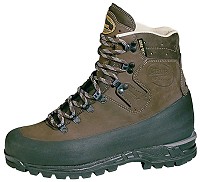
B1 for Walkers
Meindl Himalaya MFS
- RRP £229.99
- Uppers Nubuck leather with full rubber rand
- Lining Gore-Tex throughout and memory foam in heel
- Sole Meindl Multigriff by Vibram
- Crampon compatibility B1
- Weight 2310g (pair size 12)
- Sizes 6-12 (inc half sizes; women's fit also available)
It's a shameless bit of national stereotyping, but I look on Meindl as Volkswagens of the boot world, not ostentatious and flash but solid, reliable and totally Teutonic. The Himalaya MFS lives up to these standards, and feels built rather than mass produced. Most Germanic of all, it delivers a lot within a sensible budget. This is an ideal winter hillwalker's boot, offering just the right amount of support, stiffness, warmth and protection without sacrificing too much all-day walking comfort. Looked after well, it should provide years of service.
"Comfortable, winter-capable and clearly built to last"
The uppers are high quality nubuck leather, with most of the foot enclosed by a single piece to minimise the amount of stitching - always a potential source of leaks or scuff damage from rocks. All stitching is kept high on the foot out of harm's way, while the entire bottom half of the boot is wrapped in a massive protective rubber rand. Ankles are supported by a well padded high cuff, with a sculpted rim and a slight feeling of stretch to improve freedom of movement. On rough ground my dodgy ankles really appreciate the protection, and this level of support is particularly useful in a winter boot when rolling the ankle to engage all the crampon points on hard snow slopes. The tongue is comfortably soft, and stitched so high that you'd have to stand in a 7 inch puddle to flood the boot (in my large size at least). Given the amount of protection outside a Gore-Tex lining is almost redundant, but you get one anyway just to be sure (it's a rare winter boot that lacks a membrane). While we're still inside it's worth mentioning the Memory Foam at the heel, which moulds to the foot shape to offer a customised fit and reduce heel lift; it works for me, and I've had no issues with rubbing at the back. In general the fit is quite broad, in keeping with Meindl's reputation, but with a slightly higher volume toe box than typical of their range to accommodate thick winter socks.
Underfoot the Vibram/Meindl sole has just the right stiffness for a B1 boot, with enough rigidity to feel secure when kicking a crampon-free edge into hard snow but not so much that you have to clump around like Neil Armstrong. With crampons on you can front point to an extent, but while I've a friend who occasionally climbs grade II winter routes in Himalayas my personal comfort limit in these boots would probably be a grade lower. A big tough heel ledge happily accommodates a rear step-in crampon binding, but be wary; this suggests rather more climbing performance than the Himalayas deliver, and if you're choosing a semi step-in crampon then pair them carefully with the boot – you don't want something stiffer than the sole can support. These are primarily walker's boots after all.
Speaking of which, on most UK winter walking days you're going to be spending a lot of time below the snow line, so just as important as crampon fit is general all-terrain comfort mile after mile. In this the Himalayas excel. Their slight flex at the toe gives a spring to your step, while the midsole has a little shock-absorbing sponginess to soak up pounding on stony paths and forest tracks. For a winter boot the sole tread is not particularly deep, and the rubber a little on the soft side perhaps, but it seems able to cope with hard snow, slushy muck, wet grass and slimy rock.
My first outing in the Himalayas was a long snowless stomp with plenty of bogs. They shed water like a duck's back, and had ample opportunity to do so in the pathless peat. The boots felt good straight from the box (a gamble, I know) and as the Memory Foam got to know my heel the fit even seemed to improve through the day. After a summer in lighter footwear the weight and stiffness were noticeable, but not really in a bad way. I next had them out on Ben Vorlich and Stuc a'Chroin, an entirely different experience with rain, blizzards and biting wind chill, and a full variety of snow underfoot from slippery slush low down to deep drifts and glassy wind-scoured patches on the summits. Crampons came on for the northeast buttress of Stuc a' Chroin, where I went looking for a bit of mountaineering fun and got the lot – frozen turf, snowed-up outcrops, scrambling on jumbled boulders and the occasional bit of ice. It was good honest grade I sort of ground, on which the Himalayas were fine paired with 12-point crampons. Then for the long damp walk-out, with rain and bogs a-plenty. After all this I got back to the car with dry socks, and my feet had been warm all day.
Summary
Despite their ambitious name Meindl Himalayas could have been designed precisely with the British winter hills in mind, equally at home on waterlogged ground as on snow slopes. They're comfortable (for the broad-footed at least), very winter-capable and clearly built to last. If you spend most of your winter just walking then Himalayas are the bee's knees. But what if once in a while you get the urge to tackle a classic snowy ridge like the Snowdon Horseshoe, or the occasional grade I gully? They'll do that too.
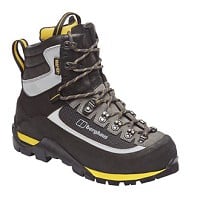
B2 for Mountaineers
Berghaus Kibo
- RRP £200
- Uppers Leather/Suede, Schoeller Keprotec, Lorica synthetic leather and full rubber rand
- Lining Gore-Tex
- Sole Vibram Granito
- Crampon compatibility B2
- Weight 2306g (pair size 12)
- Sizes 6 – 12.5 inc half sizes
The Berghaus Kibo is a jack of all trades and a master of none – a little less easy on the foot than straight walking boots, while at the same time lacking the top-end performance of a thoroughbred climbing model. But really that's the whole point. The design is a compromise between the needs of walkers and climbers, aiming at the generalist with a foot in two camps, both winter walking and low-end mountaineering. It's a good one-boot-fits-all choice for snowy UK hillwalks, classic winter ridge traverses, low grade gullies and easier Alpine summer stuff.
I've spent five winters trashing a pair of Kibos, so know them best of the three boots on test. For this review I got hold of a more recent pair, and spotted a few small differences (read on).
The uppers are a composite of several materials – leather, suede, synthetic leather, Schoeller Keprotec (whatever that is) and lots of rubber rand. I'm not sure why so many different panels have been included, but while this would normally ring alarm bells regarding long term durability I can confirm after those years of heavy use that Kibos are in most respects as tough as old boots. With that durability comes a bit of bulk. These are clod hoppers, not ballet shoes.
"A jack of all trades... a good one-boot-fits-all choice"
The thick double tongue helps hold the foot in position, and seems to add insulation; I like it, bar the creaking squeak that accompanies every step. At the rear is the 'Exo-wrap Heel'. It's a daft name for a bit of webbing that runs from the laces around the back of the foot, but the idea works well and for me there's no discernible heel lift - good for both walking comfort and the feeling of security when climbing. Lacing is smooth running, and can be locked off halfway to allow for different tightness at toe and cuff. In my experience the original laces snap after a year or two.
I find a lot of modern mountain boots too asymmetric for my (not unusually) broad-toed foot, but Kibos sacrifice a bit of the climbing precision of more technical models for a last better suited to just plain walking. Their rounded profile and roomy toe box give a less foot-punishing fit, and accommodate a bit of foot spread over a long walk. I actually enjoy (rather than just endure) days on my feet in them, and have often taken them on overnight backpacking trips when there's a chance of finding snow. If further endorsement of their walking credentials were needed it might be worth noting that Steve Perry wore Kibos on his record breaking 1500-mile continuous round of all the Munros in winter (see this UKH article). There's a very slight give in the sole, but I suspect their walking comfort is more thanks to the fairly pronounced rocker underfoot which allows a nice natural heel-to-toe roll.
Still, there's too much sole flex for secure front pointing on steeper ice, and grade II is about my happy climbing limit. I think the leverage of my big sizing is partly to blame for this, since a Kibo-owning friend with wee girly tootsies notices the flex rather less. These B2-rated boots have a solid heel ledge but no lip at the toe, so they'll only take a semi step-in crampon. Do try before you buy since they're too broad to fit some models of crampon.
These boots are named after the high point on Kilimanjaro, but having actually worn a pair here some years back I'd say they're overkill for this hypoxic scree plod and rather better suited to UK winter. I was in sandals most of the way up Kili before switching to Kibos on summit day – they'd have been too warm on the lower slopes. Still it was bitterly cold up top and Kilimanjaro's famous snows (what's left of them) were bullet hard. Thanks to the Kibo's insulation, my toes were soon the only bit of me with any feeling left. The previous week these boots had taken me up Mt Kenya's Nelion, handling all-day rock climbing up to about VDiff/Severe; we only resorted to rock shoes for one crux pitch.
Kibos have been around since 2005 and seem to have changed subtly in that time. I took the new pair for a two-day test run in the Cairngorms earlier this month, 40-odd-kilometres of heavy load carrying on the full range of ground from bogs to neve fields and a couple of grade I snow gullies. They shrugged off the wet, kept my toes toasty at minus quite a lot, and climbed as well as my older boots ever did. On the strength of this it seems comfort and performance remain good. Nevertheless I've one or two minor negatives.
My older pair were made in Europe, while the latest version is made in China. They've a slightly different sole unit, Vibram whatever-it-was having changed to Vibram Granito which has good deep treads and quite a hard rubber compound for durability and a secure bite in snow. The uppers are superficially identical, but looking closer the newer ankle cuff has lowered by a centimetre or more, as has the position of the top lace eyelets; the previous height gave marginally better support when rolling the ankle to engage all your crampon spikes on hard snow slopes. The top lace hooks are similar but different too, not as low-profile as previously. They stuck up enough that I thought them a potential trip hazard, and took a pair of pliers to them. The mid-way locking eyelet has also changed shape very slightly and one of them was failing to lock at all because the plastic moulding was a dud. Yet it is pivotal in securing a good fit. I lightly punished it with a file, while musing that for 200 notes punters shouldn't have to DIY this sort of thing. Perhaps quality control has suffered in the relocation to the Far East? Or maybe it was a one-off with this particular pair.
Summary
Kibos don't have much finesse, but they're solid, comfortable and good value. If you want one boot to cover everything from snowy Munros and long distances to bottom end winter climbs and even easy mountaineering rock then they are an excellent choice – just check the locking eyelets before you buy.
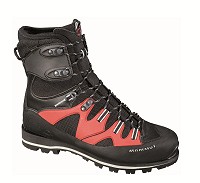
B3 for Climbers
Mammut Mamook GTX
- RRP £330
- Uppers Microfibre Racing and Dropstop Textile
- Lining Gore-Tex
- Sole Vibram Teton with carbon shank
- Crampon compatibility B3
- Weight 2248g (pair size 12)
- Sizes 6.5 – 13 inc half sizes up to 11.5, women's 4 - 9
When Mammut absorbed Swiss bootmaker Raichle they gained a big toehold in footwear. Broad-footed oafs like me gained too, since the Raichle/Mammut fit seems generally wider than most brands in the UK mountain boot market. In recent years I've mostly climbed in Raichle 90 Degree EXPs, the immediate ancestor to the Meridian in Mammut's current range. These are excellent fairly traditional leather mountain boots, but not hugely light on the foot at about 2800g a pair (size 12). Despite the weight they've handled any routes a bumbler like I could throw at them, from classic ice such as Point Five to rockier mixed things like Fingers Ridge. As with most B3 boots though, they start feeling a little clumpy on long walk-ins, and indeed for routes such as Aonach Eagach that cover lots of distance on easy ground. And did I mention the weight? With this in mind I was keen to try the slimmed-down, souped-up Mamook.
These are 'the several times awarded and lightest crampon compatible mountain shoe [sic] for technically demanding climbing' say Mammut. I'd usually expect a stiffer, warmer, full-spec climbing boot like this to weigh rather more than a B1 or B2, but the Mamook is both the lightest boot on test here, and by far the most technical. They are also noticeably less cumbersome than the various mountain boots I've used before, without sacrificing the supportive stiffness essential to B3 footwear. Mamooks have a nice deft feel, both on graded ground and (within reason) the walk-in.
At a casual glance you might think this is another leather boot, but there's actually nothing organic here – it's all lab-grown. The uppers are a mix of Microfibre Racing and Dropstop Textile, lightweight, abrasion resistant and supple. To trim weight there's reinforcement only where needed, in the form of external plastic panels (the so-called 'Hybrid Shell') which are glued to reduce the amount of exposed stitching. It's early days but so far this arrangement seems pretty tough, and I've failed to make a mark on the uppers. Just to be sure, a protective rubber rand wraps around the whole lower foot.
"They've a nice deft feel both on graded ground and the walk-in"
The tongue is soft and unobtrusively thin, and all of a piece with the textile of the uppers. It's more comfortable than traditional thick double tongues, though I can't yet say if it'll prove as warm. There's quite a high cuff which gives a good amount of support when walking on rough ground, but thanks to the flexibility of the textile upper and the way the plastic shell panel is cut out around the ankle bone dexterity is barely compromised. I've got no finesse when climbing, but even I can appreciate how this permits delicate footwork rather than hindering it. Where the cuff is cut lower at the Achilles a little neoprene 'gaiter' helps keep snow and grit out.
The rear of the boot is quite sculpted, giving a snug fit around the heel. Mammut's 'Motion Control', an anatomically shaped heel cup, is said to offer lateral stability without compromising forward flex. The foot certainly feels supported on rough ground, hopefully reducing the risk of injury. Mamooks also boast Mammut's 'Base Fit' system, free-sliding webbing bands running from the laces to the insole to hug the foot and prevent movement. Once the boots are laced I can't get any heel lift even if I try, which is great both when walking and front pointing. When descending my feet don't slide forward so there's no nasty toe jarring – good news next time I walk off The Ben via the zigzags. The lacing is slightly asymmetric, and so is the last. Together these help bring a feeling of precision to the big toe – just where you want it when climbing. However I don't find the asymmetry as radical as on some modern boots, so for me at least walking is not greatly compromised and Mamooks still feel relatively comfy at the end of a day.
Underfoot there's a Vibram Teton sole, with a medium-depth tread that seems to cope well on anything from hard snow to wet grass. The boot is designed for Alpine rock climbing as well as winter ground but after only a handful of undemanding walk-ins so far this season I've already noticeably worn down the clean-cut sole edge at the toe; I'm not sure how it'd look after a couple of years' use, particularly if often climbing crampon-free. The sole is quite low to the ground for good balance on rough terrain, and fully stiffened with a lightweight carbon shank. With reinforced ledges at heel and toe Mamooks will take a full step-in crampon (as you'd expect from a B3 boot), and pair up pretty well with my semi-auto G14s too. Climbing-wise I've only yet done a few routes this season and nothing above a IV (the usual excuses), but so far the signs are great. Having been on both ice and mixed, and even a wee bit of drytooling, I can safely say that Mamooks are more than capable on anything I'll be getting up and would also suit far better climbers. Their precision and lightness are good for footwork, while the close fit and rigidity give reassuring support when scratching around on the tips of your crampons.
Does the Mamooks' lightness compromise warmth or weatherproofing? Aside from the possible worry with the thin tongue, not that I can tell yet. In a day of really biting wind chill on Lochnagar I climbed in a belay jacket, full shell and two pairs of gloves. Still, my feet were the only warm bit. I sort of half fell in a burn on the way home, but with their high cuff and Gore-Tex lining the Mamooks just shrugged it off. That's hardly definitive, but seems promising so far. More foul weather data is needed, and I daresay I'll get plenty.
Summary
Thanks to their fit and feathery weight, walking in Mamooks feels less of an effort than the typical heavy mountain boot plod. With their rigidity they wouldn't be my first choice for a straight hillwalk, but I'd certainly consider them for the sort of backpacking and mountaineering combination on which I recently used Kibos. Accomplished climbers will really be able to put this technical boot through its paces, but you don't have to be racking up big numbers to appreciate their lightness and comfort. They're a decent choice for any hillwalker taking their first steps into winter climbing, especially if you want to future-proof your footwear to accommodate progression. As a mid-grade punter Mamooks probably won't make me climb better (there's not much hope), but I can certainly fail more gracefully in them, and I'll reach my upper grade limit long before they do. A superb bit of kit for Scottish winter climbing, and though I've not yet tried them elsewhere they promise to be ideal for continental roadside ice and Alpine mountaineering too. But they're not a budget option.




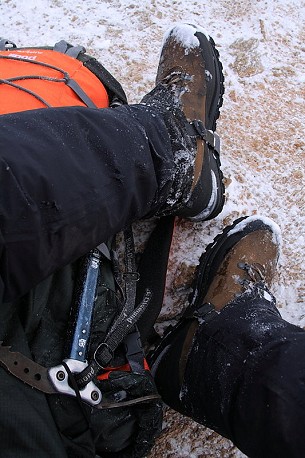
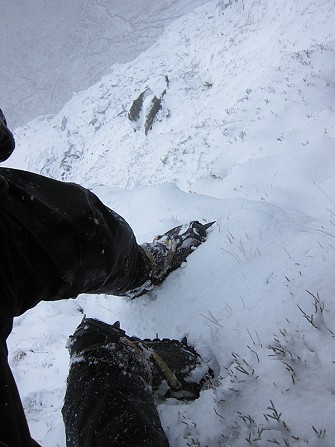
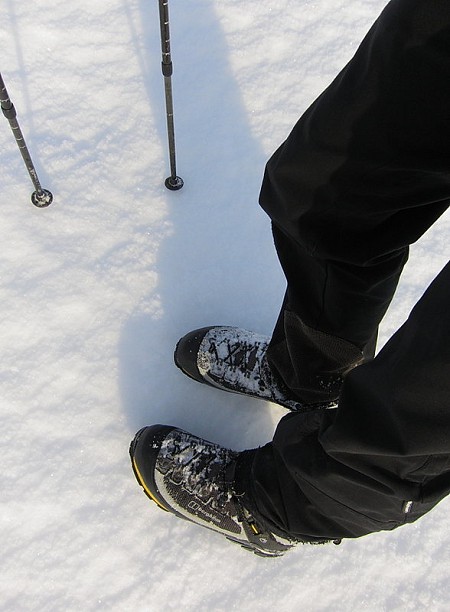
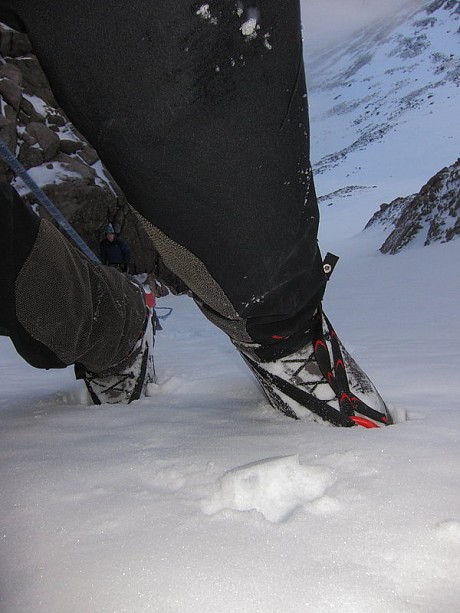
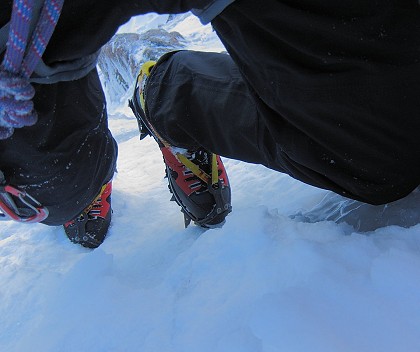
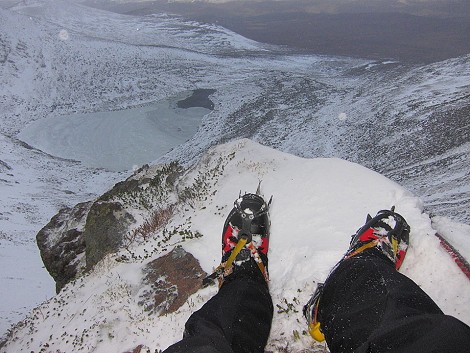
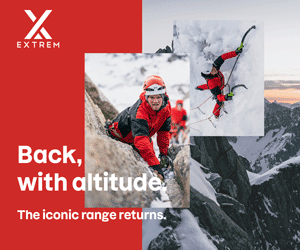
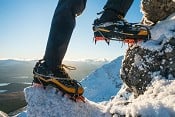
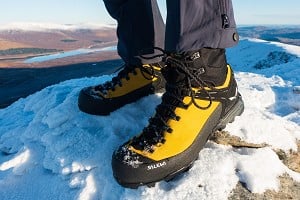
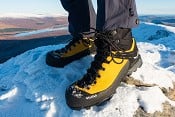
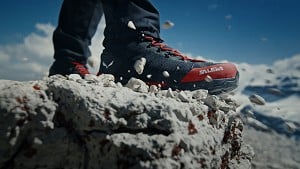

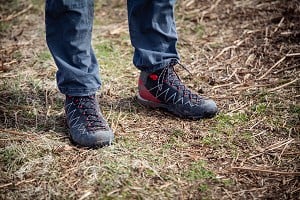

Comments